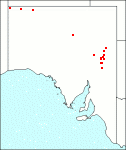Family: Poaceae
Enneapogon oblongus
Citation:
N. Burb., Proc. Linn. Soc., Lond. 153:85 (1941).
Synonymy: Pappophorum lindleyanum Domin var. glaucum Domin, Biblthca Bot. 85:380 (1915); P. nigricans R. Br. vat. barbinode Domin, J. Linn. Soc. (Bot.) 41:277 (1912).
Common name: Purple-head nineawn.
Description:
Annual or short-lived perennial 27-35 (13.5-66)cm; culms branched, pubescent close below the nodes or glabrous; blades tightly involute, acute, hispid or pilose with simple and glandular hairs or glabrous, antrorsely and retrorsely scabrous.
Panicle 1-1.8 x 0.5-1 (rarely 0.6-4.6) cm, compact, ovate or elliptic to oblong; axillary inflorescences and spikelets absent; spikelet 4-6-flowered with 1 floret fertile, often purple when young; glumes membranous to hyaline, oblong to elliptic, obtuse to truncate, erose or entire, pubescent with glandular hairs to almost glabrous; lower 2.6-3 (rarely 1.9-4.8)mm long, 5-7- (rarely 4-12-) nerved; upper 2.6-3 (rarely 5) mm long, 5-7- (rarely 3-8-) nerved; lowest floret: body c. 2.6 (rarely 1.7-4.3)mm long, membranous, with strongly ribbed nerves, bearded with hairs usually somewhat shorter than the body itself, ciliate on the margins, often with 2 nerves entering each peripheral awn; awns 2.6-3 (rarely 1.6-6.2)mm long, often 9-12 in number, ciliate in the lower two-thirds to three-quarters or sometimes for their entire length; palea of lowest floret: body glabrous in the upper half to third, hairy below; flaps narrow, hairy except near the base; keels long-ciliate in the upper two-thirds to half, thickened; grain 1-2.2 x 0.7-1 mm, obovoid to ellipsoid or oblong; embryo from half as long as, to slightly shorter than, the grain itself; second floret: lemma lightly ribbed, glabrous; palea present; rhachilla pubescent.
Published illustration:
Lazarides (1970) The grasses of Central Australia, pl. 35b.
|
|
Distribution:
|
W.Aust.; N.T.; Qld.
|
Conservation status:
native
Flowering time: May and Aug.
|

SA Distribution Map based
on current data relating to
specimens held in the
State Herbarium of South Australia
|
Biology:
Moderate grazing value.
Taxonomic notes:
Previous references to E. lindleyanus in S.Aust. are based chiefly on misidentifications of E. oblongus. The former species, which is largely confined to Qld, differs from E. oblongus by its smaller spikelets, shorter awns relative to the lemma body, glabrous lemma margins and fully pubescent palea with its shortly scaberulous keels.
Author:
Not yet available
|

